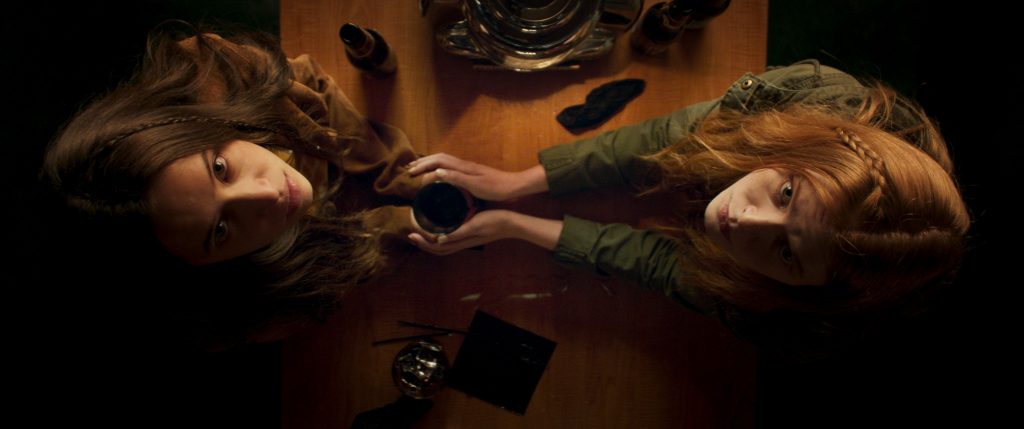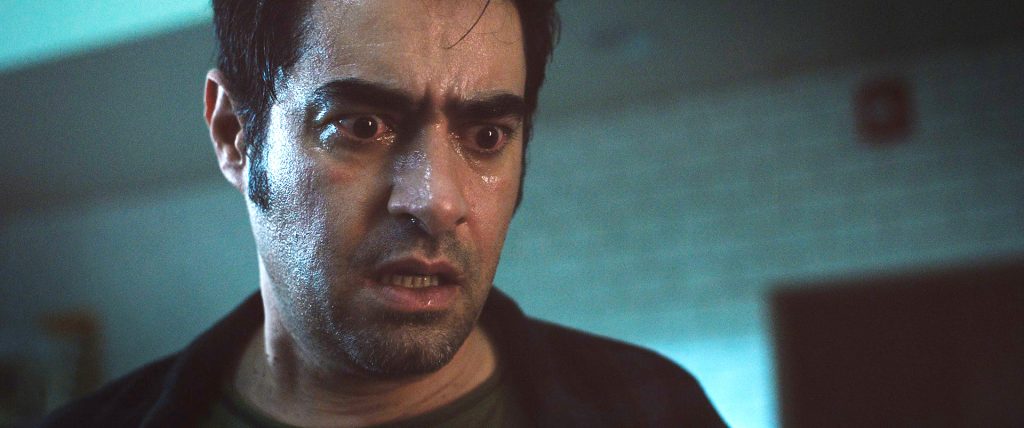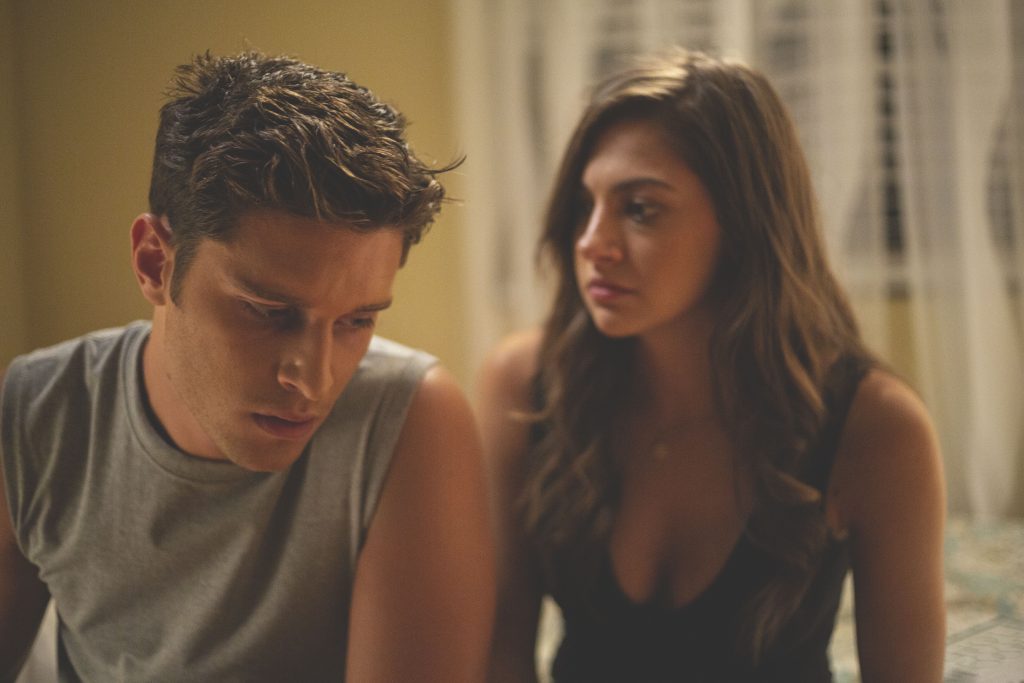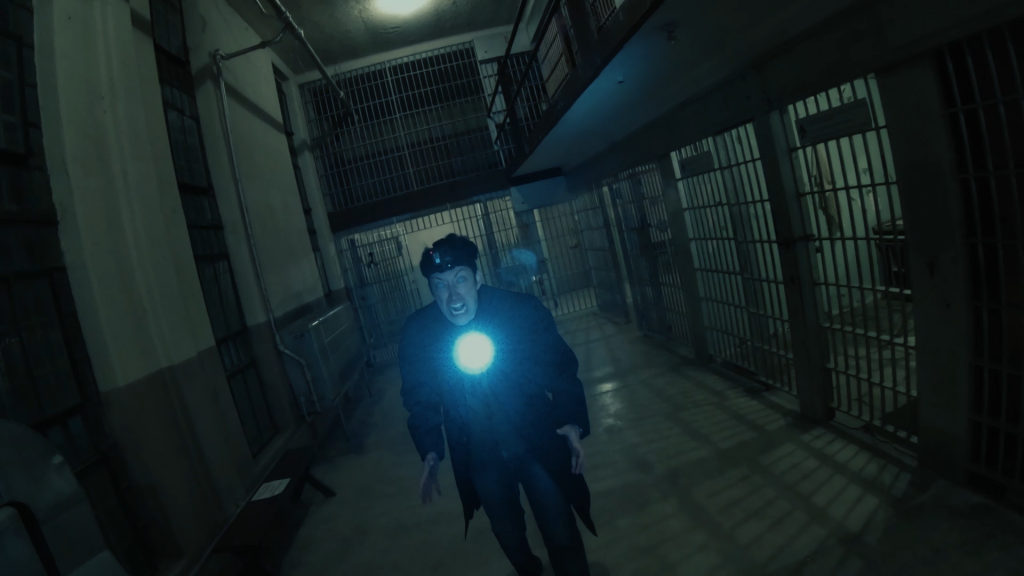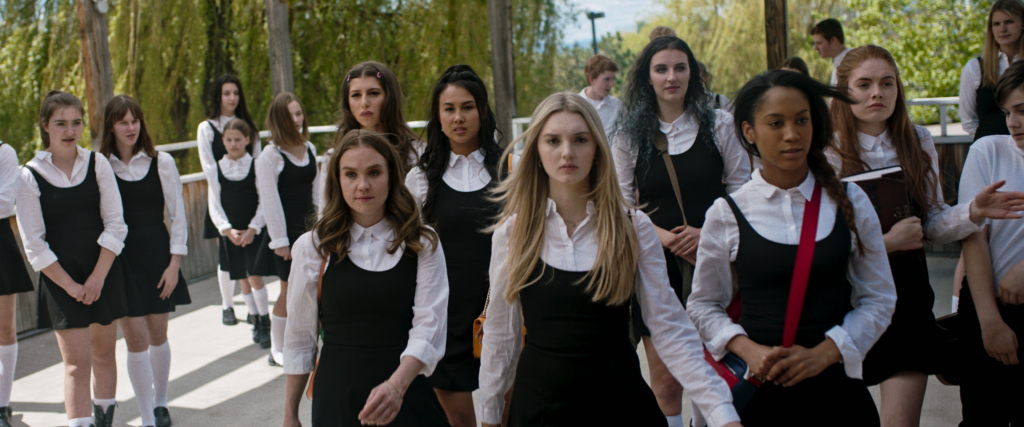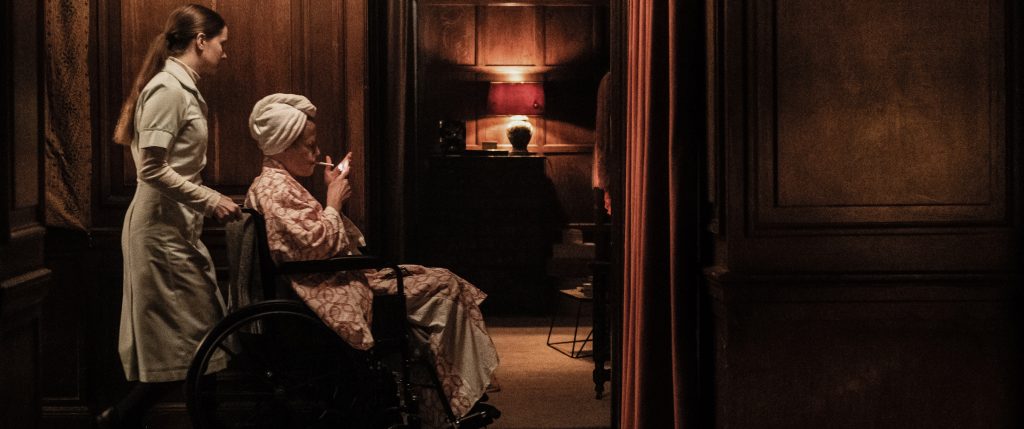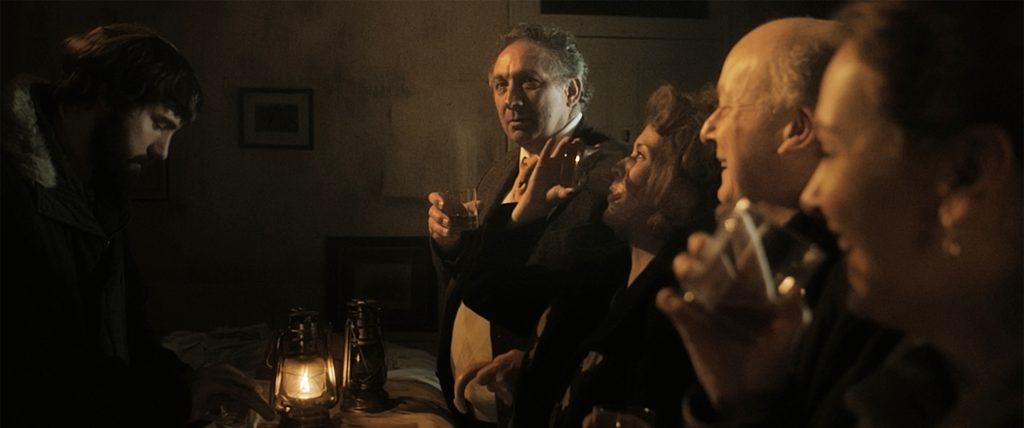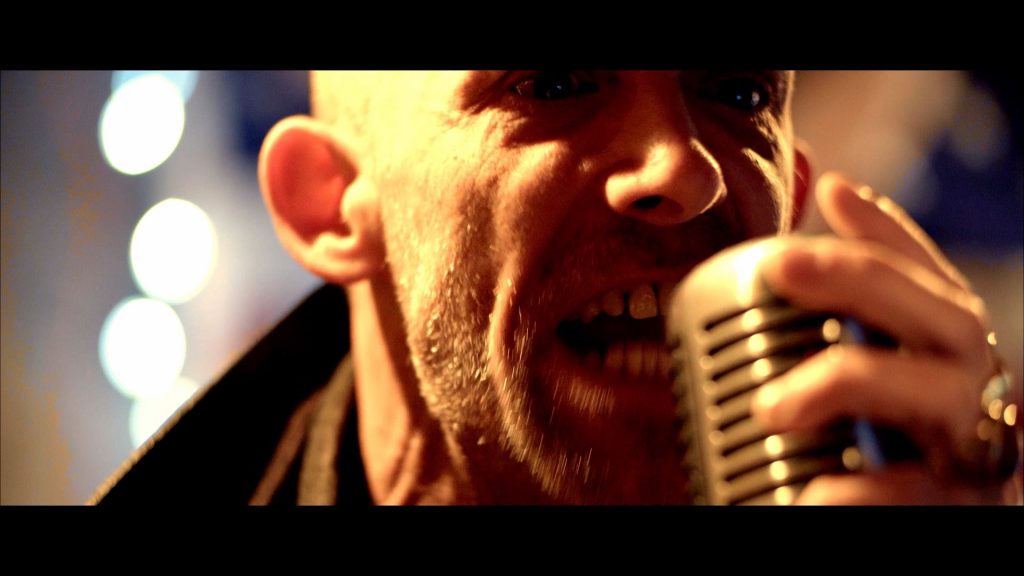March 24, 2021
by Carla Hay

Directed by Castille Landon
Culture Representation: Taking place in Tampa, Florida, the horror film “Fear of Rain” features a predominantly white cast of characters (with a few African Americans and Latinos) representing the middle-class.
Culture Clash: A schizophrenic teenage girl in high school becomes convinced that a neighbor (who also happens to be one of her schoolteachers) has kidnapped a young girl and is holding her captive in the neighbor’s house.
Culture Audience: “Fear of Rain” will appeal primarily to people who don’t mind watching tame horror movies that have a lot of missteps and dumb endings.
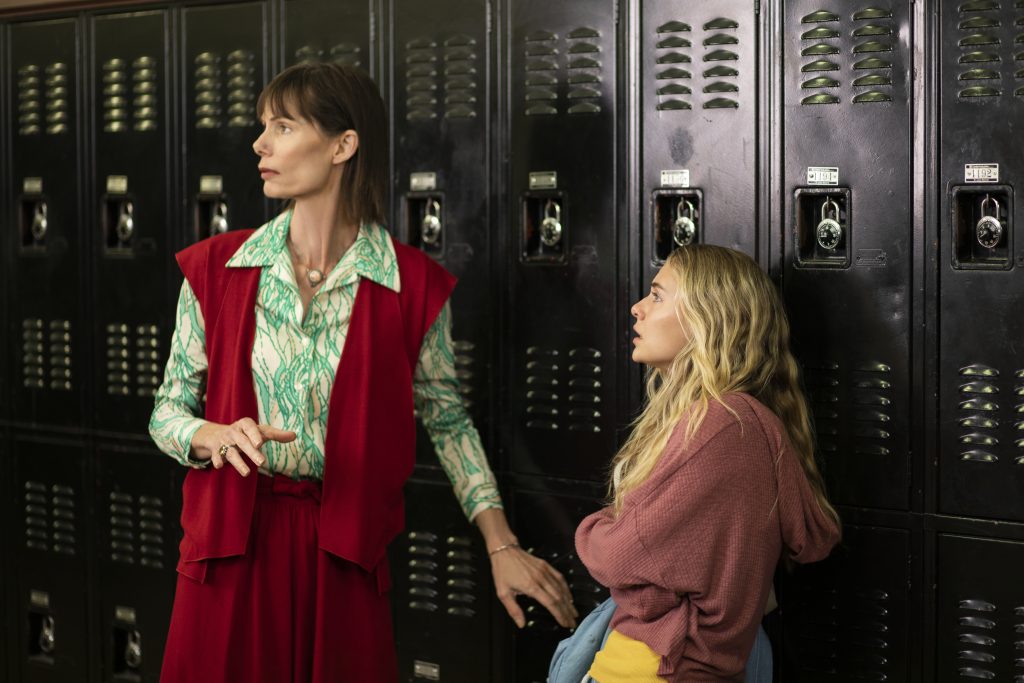
Stop if you’ve already heard this idea for a horror movie. A young female (usually blonde, usually pretty) begins to wonder if she’s going crazy because she’s convinced there’s a killer on the loose and she might be the next target. It’s a concept that’s been overdone to the point of it being a bad cliché. But that didn’t stop writer/director Castille Landon from recycling this concept and making the lackluster and unimpressive horror flick “Fear of Rain,” which has an ending that is truly moronic.
The cast members of “Fear of Rain” seem to be trying to make the best out of a terrible script. And the film’s cinematography, production design, musical score and other technical production elements are adequate. But all of that is not enough to improve the movie’s overall substandard direction.
It’s a repetitive slog of teenage schizophrenic protagonist Rain Burroughs (played by Madison Iseman) trying to convince people that things she’s seen are not part of her mental illness. The scares in this horror movie are basic and not very original. And the movie bungles a potentially good mystery with an almost laughable showdown and a bunch of nonsense that leave major questions unanswered by the end of the film.
Taking place in Tampa, Florida, “Fear of Rain” opens with a scene of Rain (who’s about 16 or 17 years old) being chased through the woods at night by a hoodie-wearing man whose face is obscured. He grabs her by the legs, drags her, and ties her hands and legs with belts. Then he buries Rain in a shallow grave. But when he leaves, she’s able to climb out of the grave.
It turns out that this horrific experience is just a nightmare that Rain is having while she’s strapped to a gurney in a hospital. While she’s restrained, a hospital attendant injects an unidentified drug into Rain’s arm to calm her down. Get used to this “it was only a nightmare” trickery when watching “Fear of Rain” because this dumb movie has plenty of it.
Rain’s worried parents are in the room with her as she’s getting sedated. Even though Rain is clearly mentally disturbed, her parents Michelle Burroughs (played by Katherine Heigl) and John Burroughs (played by Harry Connick Jr.) ignore all advice to put Rain in a psychiatric facility. It’s unclear how long Rain has been diagnosed as a schizophrenic, but most schizophrenics start showing symptoms in adolescence.
Dr. Ellen Pangloss (played by Enuka Okuma), the hospital psychiatrist who evaluates Rain, tells her that Rain’s “episodes get increasingly worse each time you go off your meds.” Rain tells the doctor that her meds “make me feel like a zombie. I can’t paint and I can’t feel anything.”
Dr. Pangloss is empathetic, but she warns Rain: “One more misstep and the state is going to institutionalize you.” What exactly has made Rain so dangerous to herself or society? The movie never really explains, but there are some hints throughout the story.
When she’s back at home with her parents, Rain (who is an only child) hesitantly goes in her bedroom, which looks like someone trashed the place. She has a flashback to the meltdown that she had in the bedroom, where she got so violent that her father had to physically restrain her. It’s implied that this incident is what landed her in the hospital.
Rain’s father John tells her that he has plans to clean up her bedroom, but in the meantime, Rain can stay in one of the house’s spare rooms. Both of her parents lecture Rain about how important it is for her to keep taking her medication. Rain’s mother Michelle has a more disciplinary attitude about it than her father does. But there comes a time when even John loses his patience with Rain.
Rain likes to paint portraits as a hobby. She’s shown spending some mother-daughter bonding time with Michelle, whose portrait Rain has painted. At home, Rain is fairly obedient and the only thing she rebels against her parents about is taking her medication. Rain agrees to start taking her meds again because she knows it’s possible that she could be involuntarily put in an psychiatric institution if she has another psychotic break.
At school, Rain is a loner and an outcast. Students gossip about her behind her back. When she returns to school and is near the lockers in the hallway, Rain accidentally drops a medication bottle and all of her pills spill out on the floor. Some students stare at her with mild disgust or ridicule as an embarrassed Rain picks up the pills from the floor.
And the movie predictably has a “mean girls” scene, where Rain tries to sit down next to some girls in the school cafeteria, but they won’t let her. Rain then goes outside to eat by herself, and she’s approached by a fellow student named Caleb (played by Israel Broussard), who strikes up a friendly conversation with her. Caleb and Rain have never met before, but he seems to know who she is.
Caleb asks Rain if she wants to play tarot cards with him. It’s an unusual way for a teenage guy to approach someone, but Rain doesn’t mind thinking that Caleb could be an oddball because he is kind and respectful to her. You know where this is going, of course. Caleb becomes Rain’s love interest. However, she’s afraid to tell him that she’s schizophrenic.
Meanwhile, Rain has a teacher at school named Dani McConnell (played by Eugenie Bondurant), who seems happy to have Rain return to her class. It’s hinted at but not described in detail that Rain and Dani had a past altercation (which is not shown in the movie) where Rain physically assaulted Dani, who filed a complaint but decided not to press charges. It’s one of the violent incidents that’s part of Rain’s troubled history that could be used against her if she’s involuntarily committed to a psychiatric institution.
When Rain and Dani have a moment alone, Dani expresses that she genuinely wants Rain to have a healthy recovery, and they should move forward from any differences they might have had in the past. Rain seems to want the same thing. But when Rain is at a drugstore, viewers see that Dani is there too. And unbeknownst to Rain, Dani is staring at Rain in a very creepy way.
You know what that means. Rain and Dani are going to have some type of conflict again. One night, shortly after Rain and Dani have their “reconciliation” talk at school, Rain sees something very disturbing from her bedroom window: The house across the street has a girl, who’s about 5 or 6 years old, trapped in the attic. Rain sees the girl yelling for help at the attic window before a shadowy unidentified adult snatches the girl away.
And guess who lives in that house across the street? Rain’s teacher Dani. And why is it suspicious that Dani would have a child in her attic? Because Dani is a spinster who lives alone and almost never has visitors.
Rain is so freaked out by what she saw that she tells her father and insists that they go immediately to Dani’s house to investigate. John is very reluctant because he thinks that what Rain saw was probably a schizophrenic hallucination. But she tells her father that she wasn’t imagining things, so they go over to Dani’s house.
Dani is calm when answering the door. John apologetically tells her that he and Rain have stopped by to check if everything was okay because Rain saw someone in the attic. Dani willingly shows them her attic, which is filled with dolls. Dani explains that her grandmother made these dolls by hand, and the dolls were passed on as an inheritance to Dani.
Dani also says that she hasn’t been in the attic in several years. Rain looks at the attic window and notices that there are fingerprints in the dust on the window. As John and Rain look around the attic, they don’t see anyone else there. Rain wants to search the rest of the house, but an embarrassed John tells Rain that it won’t be necessary. He apologizes to Dani for disturbing her. And then he and Rain leave.
When Rain gets home, she and John have a big argument. She’s certain that Dani is lying because Rain said that in the attic, she saw a 2018 almanac, which contradicts what Dani said about not being in the attic for several years. Viewers have to assume that this story takes place within a few years of 2018. John doesn’t think that the almanac is enough proof.
John yells at Rain, “There’s no one up there! It’s your mind playing tricks against you! Please stay away from that house! If she files another complaint, the state is going to put you in the hospital!”
Meanwhile, Rain continues to have nightmares that take place the woods. In one such dream, a group of people in the woods stare at a painting of Rain that comes to life. And the movie shows another scene in the woods where maggots come out of someone’s hands. These are very mild scares and don’t add anything to the story, especially when viewers find out how the movie ends.
At school, Rain is now terrified of being near Dani. When Rain accidentally bumps into Dani in the hallway, Rain’s horrified reaction is as if she bumped into a serial killer. And at some point in the story, Rain finds out some things that convince her that Dani kidnaps and murders children.
Meanwhile, Rain and Caleb become closer. Rain confides in him about her suspicions of Dani, while continuing to keep her own schizophrenia a secret from Caleb. The Caleb character is basically a retread of the nerdy and nice boyfriend character that Broussard has in the “Happy Death Day” horror movies, where he also plays the loyal believer of the young and pretty protagonist who has visions of crimes that other people say are delusions.
Caleb has a few odd quirks (he doesn’t have a cell phone and he’s unusually fascinated with tarot cards), but he’s supportive of Rain and he tries to keep an open mind when she tells him things that sound very far-fetched. Rain convinces Caleb to go to a local library with her to help her look up missing kids nationwide to see if they can identify the girl whom Rain says she saw in the attic window. They find a photo of a missing girl from another state named Malia Robinson (played by Hudson Rodgers), and Rain is convinced it’s the same girl.
Even when Rain starts to act more paranoid, Caleb is patient with her, but he does express some skepticism when Rain begins to sound really crazy. At school, when Rain sees some cops on campus, she crouches down behind a car and tells Caleb to do the same to hide from the cops. Why? Because she says the cops are looking for her.
Things really go downhill from there, as Caleb and Rain try to play detective and further investigate (translation: spy on) Dani. And then, there’s an asinine plot manipulation where Rain begins to wonder if Caleb is real or in her imagination. Viewers who make it through watching “Fear of Rain” until the horrible end will wish it wasn’t a reality that they wasted time watching this entire messy garbage pile of a movie.
Lionsgate released “Fear of Rain” in select U.S. cinemas, on digital and VOD on February 12, 2021.

